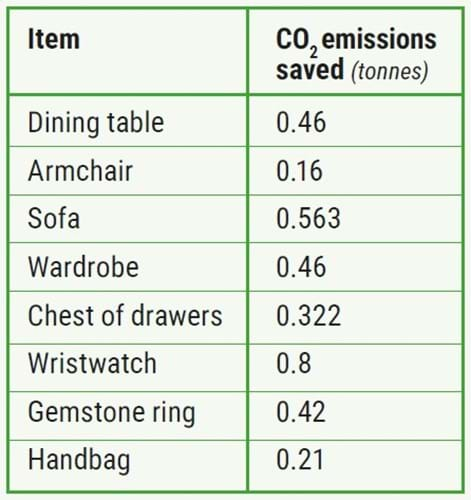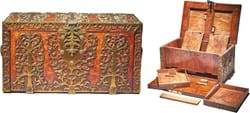
Finding a bargain was the top reason for buying second-hand items but environmental concerns were second.
Chattels auctioneers and dealers stalling out at fairs and markets will certainly hope so and a number of trends and recent announcements suggest that it might well be.
With the COP27 climate summit this month keeping sustainability top of many people’s minds, the environmental benefits of not buying new are gradually seeping into consumers’ consciousness. Almost three-fifths of people (58%) now know that buying second-hand furniture is greener than buying new, up from 53% three years ago, according to a recent survey of UK consumers by ATG’s parent company Auction Technology Group.
The survey found that 44% of people are more likely to buy second-hand now than they were three years ago , with a further 43% saying they are just as likely. Respondents said that the top two reasons for buying second-hand are saving money and awareness of it being more environmentally-friendly (see graph above).
The impact of sustainable buying as a reason to purchase used items was found to be more important to women and young people.
Younger buyers
Indeed, the rise in interest in secondary market items may well bring new clients from among the younger demographics.
The survey found that 18-25s are the most likely to buy used clothes, jewellery and watches and 25-44-year-olds are more likely to buy collectables and furniture second hand than any other age group.
The current cost of living crisis may also encourage some consumers to look even more actively at the wide range of second-hand good available at auctions and showground fairs.
A report published this month by Wrap (the Waste and Resources Action Programme, a climate action charity) found that if all home furniture in the UK that is suitable for reuse were resold rather than discarded then UK households buying these items – instead of new furniture – would collectively save £2.37bn a year. For clothing the saving would be even higher at £4.51bn a year.
Gift options
At this time of year shoppers are also increasingly considering second-hand items as presents – encouraging news for auction houses holding Christmas-themed sales and for antiques markets taking place in the coming weeks.
The latest monthly snapshot of spending by Barclaycard, which accounts for half of debit and credit card transactions, found that 50% of consumers were planning measures such as buying second-hand as a way of keeping their seasonal spending under control.
“Consumers are adopting a restrained approach to festivities, looking for preloved gifts and setting spending limits to manage their costs,” said Esme Harwood, a director at Barclaycard.
Similarly, a survey by eBay found that 38% of consumers will be shopping for secondhand or refurbished products this Black Friday (November 25). The online marketplace said it will promote only refurbished and pre-loved deals for Black Friday this year.

CO2 emissions graph quantifying the carbon emissions saved when purchasing popular items used rather than new.
Dealers and auctioneers seeking to promote the environmental benefits of buying second-hand to their clients are welcome to use the data published last year by Auction Technology Group (see box above) which quantifies the carbon emissions saved when purchasing popular items used rather than new.
Just how green is it to buy second-hand these days? A study conducted by Small World Consulting on behalf of Antiques Trade Gazette parent company Auction Technology Group set out to provide the answer.
Looking at a sample of items sold on thesaleroom.com, the consultants estimated the carbon emissions saved compared with purchasing similar items new.
Unlike some second-hand items such as cars, furniture has no in-use emissions and all of its embodied emissions from its original manufacture can be assumed to have already been ‘written off’ by the person who first bought the product. Thus, for example, the buyer of a standard wardrobe or dining table might save an estimated 460kg – nearly half a tonne – of CO2 emissions compared with buying a similar one new as that amount is about what it would take to manufacture the latter.
Given the annual carbon footprint of a person in the UK (which includes all their consumption and travel) is estimated to be about 13 tonnes*, saving almost half a tonne in one purchase by buying a dining table second-hand is a significant contribution to reducing personal carbon emissions. The emissions involved in manufacturing a new mechanical wristwatch are even higher, meaning that buying a used watch can save around 0.8 tonnes of CO2 emissions.
* according to the book How Bad Are Bananas? The Carbon Footprint of Everything by Mike Berners-Lee, founder and director of Small World Consulting and professor at Lancaster University’s Environment Centre.
Source: Analysis of the carbon footprint of a basket of popular items sold through Auction Technology Group’s marketplaces, calculated by Small World Consulting on behalf of ATG. All product carbon assessment contains considerable uncertainty. Each carbon estimate was based on a series of product-based assumptions. We allocated all the embodied emissions of new products to their original purchaser, so that secondhand goods contained no embodied carbon. We assumed that end-of-life emissions were very small compared to other life cycle stages, so end-of-life emissions were not included in our estimates.













